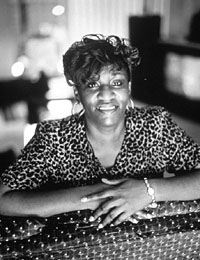
Among the "Faces of Hope" on view at the Law School exhibit are (top) Jack Jones, of Terry, Mississippi and Jacque White of Big Sandy, Texas.
|
of people living with HIV
"Faces of Hope: AIDS and Addiction in America," a photographic essay on display at the Law School, features 18 portraits by David Armstrong that seek to personalize the struggle to overcome substance abuse by individuals who are HIV-positive.
Designed to convey the courage and grace of those confronting AIDS and addiction, the portraits were commissioned by the Legal Action Center in New York as part of a project cosponsored by the center's Arthur Liman Policy Institute and the Yale Law School's Arthur Liman Public Interest Program. The exhibit will travel to Washington, D.C. and New York later this spring.
The faces in the exhibit reveal the diverse populations affected by the AIDS virus. Each portrait is accompanied by a testimonial written by the photographed individual. In his testimonial, 41-year-old Jack Jones of Terry, Mississippi, notes, "What I say to people is: Get on with your life. Do what you are supposed to do -- take your medications and have a positive attitude -- and live a normal life." The testimonial by 42-year-old Jacque White of Big Sandy, Texas, offers this advice: "Pratice safer sex."
The guiding spirit behind the "Faces of Hope" project is Felix Lopez, director of the Liman Institute at the Legal Action Center as well as a 1991 Law School graduate and former assistant dean of Yale College. Together with Armstrong, who has had several solo exhibits in the United States and Europe, Lopez traveled widely in an effort to capture, in both photographic and text form, the stories of people with AIDS who have succeeded in confronting substance abuse problems. In addition to the exhibits, their visual and narrative essay will be published by the Legal Action Center in a book intended to break down barriers of ignorance and bias with respect to people in recovery and people living with AIDS.
"The Faces of Hope" exhibit opened on the eve of the fourth annual Arthur Liman Public Interest Colloquium -- "Encountering the Criminal Law: Implications of Contemporary Law Enforcement Practices for Civil Rights and Civil Liberties" -- held at the Law School on March 2. Attended by over 150 people, the Liman Colloquium explored the diversion of criminal defendants into alternative sentencing courts, including drug courts, as well as issues of racial profiling and immigration law enforcement abuses.
Along with the "Faces of Hope" exhibit, the colloquium was designed to highlight the work of the Liman Public Interest Fellows, who are graduates of the Law School committed to legal work in the public interest. The program honors Arthur Liman (LAW '57), who was founding president of the Legal Action Center and led the Neighborhood Defender Service of Harlem and the Legal Aid Society of New York in addition to his work as a partner at Paul, Weiss, Rifkind, Wharton & Garrison. This year's Liman Fellows are Marjorie Allard (LAW '99), who
Next year's Liman Fellows were also announced at the March 2 colloquium. They are: Susan Hazeldean (LAW '01), who will engage in public education and representation of homeless teenagers at the Lesbian and Gay Youth Project of the Urban Justice Center in New York; Serena Hoy (LAW '00), who will work with the Capital Area Immigrants' Rights Coalition to represent individuals who the U.S. government seeks to deport on the basis of prior criminal convictions; and Joe Luby (LAW '98), who will represent death-row inmates, and seek to assist private bar counsel in so doing, as an attorney with the Public Interest Litigation Clinic of Missouri.
"Faces of Hope" can be seen 8 a.m.-midnight through April 13 in the Alumni Reading Room, which is adjacent to the student lounge on the main corridor of the first floor of the Law School, 127 Wall St.
T H I S
Bulletin Home
is an attorney at the Alaska Public Defender Office in Anchorage, where she works on drug courts issues; Rebecca Bernhardt
(LAW '97), who is in Austin, Texas with the Immigrants' Rights Project of the Lawyers' Committee for Civil Rights Under Law; and Kenneth Sugarman (LAW '97), who conducts racial profiling litigation on behalf of the American Civil Liberties Union of Northern California in San Francisco.
 W E E K ' S
W E E K ' S S T O R I E S
S T O R I E S![]()
 Economist will develop better way to measure economic activity in U.S.
Economist will develop better way to measure economic activity in U.S.
![]()
![]()
 Yale SOM to establish database for study of world's financial history
Yale SOM to establish database for study of world's financial history![]()
![]()
 F&ES to create industrial ecology program in Asia
F&ES to create industrial ecology program in Asia![]()
![]()
 Greene and Brisman awarded DeVane Medals
Greene and Brisman awarded DeVane Medals![]()
![]()
 Professor Lane explains the economics of happiness
Professor Lane explains the economics of happiness![]()
![]()
 Scientist Thomas Steitz honored with Sterling Professorship
Scientist Thomas Steitz honored with Sterling Professorship
![]()
![]()
 Goldman-Rakic is Eugene Higgins Professor of Neurobiology
Goldman-Rakic is Eugene Higgins Professor of Neurobiology
![]()
![]()
 Joan Steitz cited as outstanding woman scientist
Joan Steitz cited as outstanding woman scientist
![]()
![]()
 Student actors 'take flight' in comic version of 'The Birds'
Student actors 'take flight' in comic version of 'The Birds'
![]()
![]()
 Exhibition examines photographers' contrasting images of Saarinen designs
Exhibition examines photographers' contrasting images of Saarinen designs
![]()
![]()
 'Faces of Hope' offers portraits of people living with HIV
'Faces of Hope' offers portraits of people living with HIV
![]()
![]()
 Model urges students to take pride in their bodies
Model urges students to take pride in their bodies
![]()
![]()
 'Cities and Buildings' pays tribute to urban works . . .
'Cities and Buildings' pays tribute to urban works . . .
![]()
![]()
 Forum to explore fate of U.S. 'melting pot'
Forum to explore fate of U.S. 'melting pot'
![]()
![]()
 Discovery boosts understanding of hereditary blindness
Discovery boosts understanding of hereditary blindness![]()
![]()
 Grants will support Yale researcher's study on how to quell the 'voices' . . .
Grants will support Yale researcher's study on how to quell the 'voices' . . .![]()
![]()
 Women under 60 more likely to die after heart attack, says study
Women under 60 more likely to die after heart attack, says study![]()
![]()
 Renowned nuclear physicist to discuss 'Science, Technology and Politics'
Renowned nuclear physicist to discuss 'Science, Technology and Politics'![]()
![]()
 'A Taste of Inequality' explores issues still on feminist frontline
'A Taste of Inequality' explores issues still on feminist frontline![]()
![]()
 Love songs will be dramatized in workshops
Love songs will be dramatized in workshops![]()
![]()
 New fund will support activities for teachers of religious studies
New fund will support activities for teachers of religious studies![]()
![]()
 New ways of funding environmental enterprises to be examined
New ways of funding environmental enterprises to be examined![]()
![]()
 Film series focus on the banned and Brazilian
Film series focus on the banned and Brazilian![]()
![]()
 Innovation is focus of this year's Spring Teaching Forum
Innovation is focus of this year's Spring Teaching Forum![]()
![]()
 Annual Pride Week celebration will feature talks, comedy night and film
Annual Pride Week celebration will feature talks, comedy night and film![]()
![]()
 Campus Notes
Campus Notes![]()
 |
| Visiting on Campus
Visiting on Campus |
| Calendar of Events
Calendar of Events |
| In the News
In the News |
| Bulletin Board
Bulletin Board![]()
Yale Scoreboard |
| Classified Ads
Classified Ads |
| Search Archives
Search Archives |
| Deadlines
Deadlines![]()
Bulletin Staff |
| Public Affairs Home
Public Affairs Home |
| News Releases
News Releases |
| E-Mail Us
E-Mail Us |
| Yale Home Page
Yale Home Page
